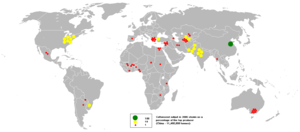- Image via Wikipedia
Cotton has held an important significance for mankind for thousands of years.
The earliest traces of cotton were found in caves in Mexico that proved to be over 7,000 years old, and 3,000 years ago Egyptians were growing, spinning and weaving cotton cloth. Cotton was brought to Europe in 800AD, and by 1500 it was known around the world, yet it was the Industrial Revolution that paved the way for the fast-growing textile industry and today it is the world’s most important fiber.
Not only are all parts of the cotton plant economically useful, but the multitude of uses it can be put to make it America’s number one value-added crop. The fiber is used for cotton cloth, while the short fuzzy linters provide cellulose for making plastics, explosives, paper products and padding for furniture. The cottonseed is crushed to produce oil for shortening, cooking or salad dressing, and the meal and hulls become animal feed and fertilizer. The stalks and leaves are re-ploughed to enrich the soil.
Over the years we have crushed, extruded and woven cotton into many forms, but even today scientists and entrepreneurs are transforming the ways we use cotton. Cotton Incorporated, the research and marketing company representing upland cotton in the U.S., is championing seven new cotton-using companies for their sustainability. “At Cotton Incorporated, we define sustainability as practices that create an environmental, economic and societal benefit,” explains Dr. Kater Hake, Vice President of Agricultural and Environmental Research at Cotton Incorporated. “The developments of these organizations certainly address those three tiers of sustainability, and demonstrate the seemingly infinite uses for the cotton plant.”
Recycled cotton
Bonded Logic have come up with an innovative new way of recycling your old denim jeans – it’s using them to create durable housing insulation. The company’s UltraTouch Denim Insulation gained fame through a drive calledCotton. From Blue to Green in 2006, which awarded communities in need through the creation and development of community-based green buildings.
With Americans buying 450 million pairs of jeans annually, weighing in at roughly 2.1 lbs (1 kg) per pair, they are a great source of high-quality material. UltraTouch has all the advantages of jeans themselves, making insulation that is warm, soft, durable and easy to work with. Cotton is often criticized for its water-intense production, but with jeans living a second life as insulation, and Levis introducing their WaterLess line in January 2011, jeans could continue to be a stylish yet greener lifestyle choice.










